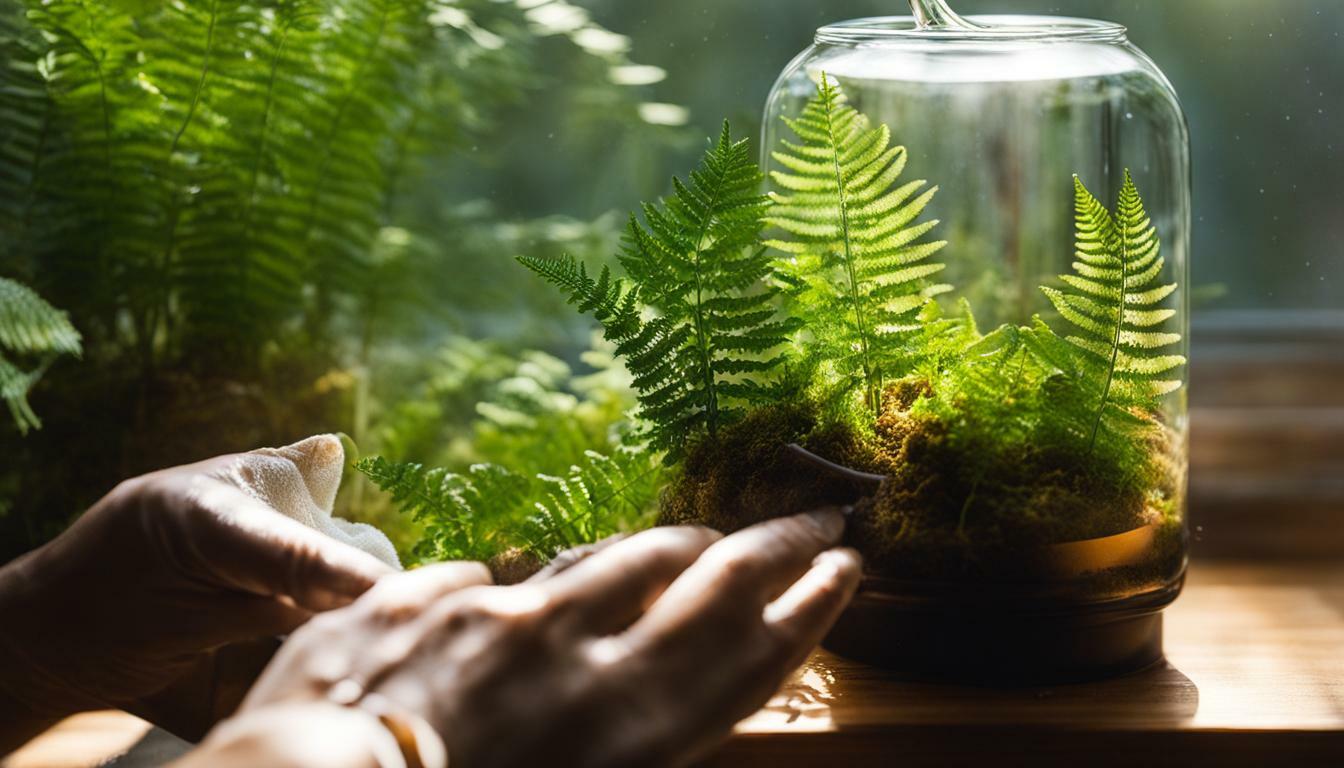Cleaning and dusting your terrarium is crucial for maintaining its health and enhancing its beauty. Proper care and maintenance will ensure that your terrarium thrives and remains a beautiful addition to your indoor space. Here are some expert tips to help you in the process:
Key Takeaways:
- Place your terrarium in a suitable location based on the light requirements of your plants.
- Water your terrarium correctly, considering whether it is a closed or open terrarium.
- Regularly trim and prune your terrarium plants to maintain their shape and prevent overcrowding.
- Keep the glass of your terrarium clean by gently wiping it with a soft cloth.
- Act promptly if you notice any bugs in your terrarium to prevent further damage.
By following these expert tips, you can ensure that your terrarium remains healthy and visually appealing. Remember to avoid common mistakes, such as placing your terrarium in direct sunlight or neglecting its regular cleaning. With proper care and attention, your terrarium will flourish and bring natural beauty to your environment.
Understanding Terrarium Care Basics
To ensure the longevity and visual appeal of your terrarium, it’s important to understand the fundamental aspects of terrarium care. Cleaning and dusting your terrarium regularly is essential for maintaining its health and aesthetics. Here are some expert tips to guide you:
- Place your terrarium in the right spot: Consider the light requirements of the plants you have chosen. Different plants have different light needs, so it’s crucial to find the ideal location that provides the right amount of sunlight. Some plants thrive in bright, indirect light, while others prefer more shade.
- Water your terrarium correctly: Closed terrariums require less watering as they maintain their own humidity. It’s best to monitor the moisture levels and only water when necessary. On the other hand, open terrariums should be watered every 3-6 weeks, depending on the moisture needs of the plants.
- Trim and prune your terrarium plants: Regular pruning is essential to maintain the shape of the plants and prevent overcrowding. Remove any dead or wilted leaves and trim back any overgrown branches. This will not only keep your terrarium visually appealing but also promote healthier growth.
Keeping the terrarium glass clean is also an important aspect of care. Gently wipe the glass with a soft cloth to remove dust and fingerprints. Avoid using harsh chemicals that can damage the glass or harm the plants. A clean glass will allow optimal light to penetrate and showcase the beauty of your terrarium.
Expert Tip:
“Act quickly if you notice any bugs in your terrarium, as they can spread and harm other plants. Regular inspection and prompt action are key to maintaining a healthy terrarium environment,” says Dr. Green, a renowned botanist.
Avoiding common mistakes is crucial to ensure the well-being of your terrarium. Some common mistakes to avoid include placing the terrarium in direct sunlight, neglecting to trim plants, allowing the glass to get too dirty, and infrequent cleaning.
By following these essential terrarium care basics, you can create a thriving and visually stunning terrarium that will bring a touch of nature into your indoor space.
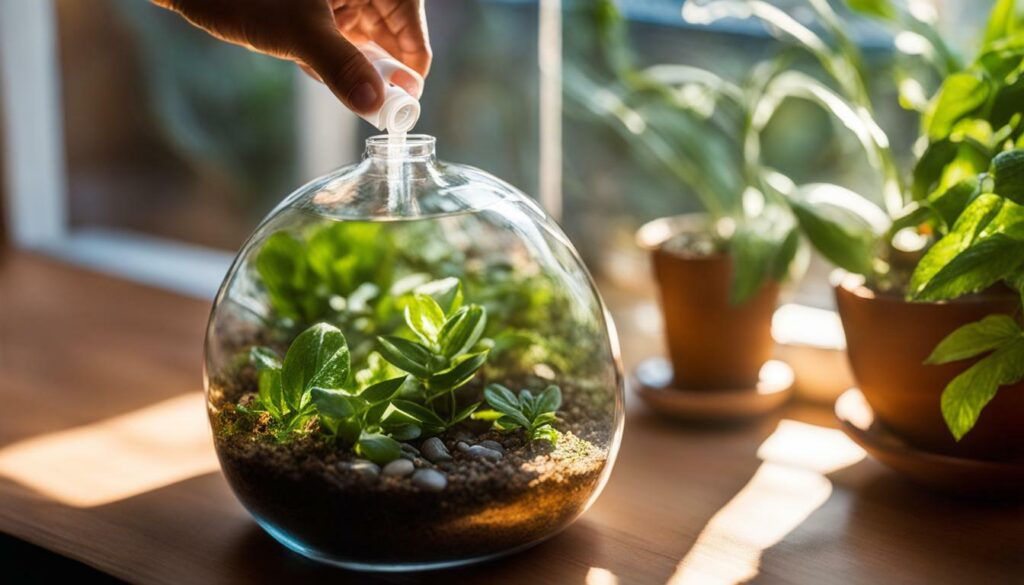
Properly positioning your terrarium and implementing appropriate cleaning techniques are vital for its overall well-being. Here are some key tips to help you place and clean your terrarium:
- Consider the light requirements: Different plants have different light needs. Make sure to place your terrarium in a location that provides the right amount of light for the plants you have chosen. Some plants thrive in bright, indirect light, while others prefer more shade.
- Keep away from direct sunlight: While it’s essential to provide adequate light, direct sunlight can often be too intense and lead to heat damage. Avoid placing your terrarium in direct sunlight, as it can result in burned leaves or overheating.
- Avoid extreme temperature changes: Terrariums prefer stable temperatures, so keep them away from drafty areas or heat sources like radiators. Sudden temperature fluctuations can stress the plants and affect their overall health.
Aside from proper placement, regular cleaning is crucial to maintain the cleanliness and transparency of your terrarium glass. Here are some cleaning tips to ensure your terrarium remains beautiful:
- Gently wipe the glass: Use a soft cloth or sponge to clean the glass of your terrarium. Avoid using harsh chemicals or abrasive materials that can scratch or damage the glass.
- Remove stubborn stains: If you encounter stubborn stains on the glass, you can try using a mixture of water and mild dish soap. Apply it to the stained area, let it sit for a few minutes, and gently scrub with a soft brush or sponge.
- Prevent algae growth: Algae growth is a common issue in terrariums. To minimize it, avoid overwatering and ensure proper airflow within the terrarium. If you notice algae, gently remove it with a clean cloth or sponge.
Table 1: Recommended Placement Tips
| Plant Type | Light Requirement | Positioning Tips |
|---|---|---|
| Succulents and cacti | Bright, indirect light | Place near a sunny window |
| Ferns and mosses | Low to medium light | Keep away from direct sunlight |
| Tropical plants | Indirect, filtered light | Provide shade or use sheer curtains |
Remember, proper placement and regular cleaning are key to maintaining a thriving and visually appealing terrarium. By following these tips, you can ensure your terrarium remains a beautiful addition to your indoor space.
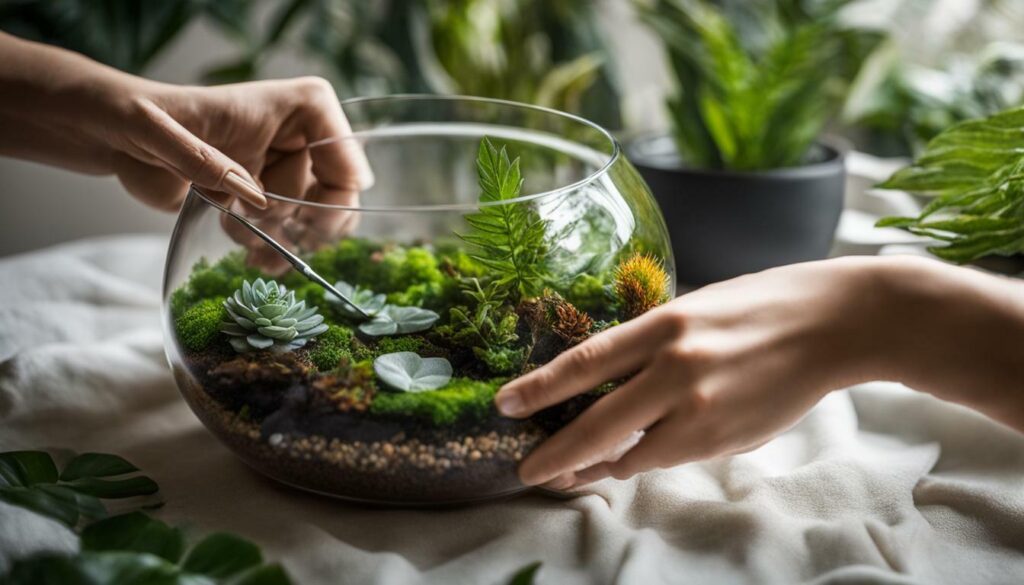
Understanding the watering needs of your terrarium and adopting the appropriate watering routine is essential for its care. Whether you have a closed or open terrarium, knowing how often and how much to water is key to maintaining a healthy environment for your plants.
For closed terrariums, such as those with a lid or cover, the moisture is largely self-contained due to the recycling of water vapor. As a result, these terrariums require less frequent watering. A good rule of thumb is to check the condensation on the inner walls of the terrarium. If there is a lot of moisture buildup, it indicates a humid environment and watering can be reduced. On the other hand, if it appears dry, you can add a small amount of water to maintain the desired humidity.
Open terrariums, on the other hand, allow for more airflow and require regular watering. Typically, these terrariums should be watered every 3-6 weeks, depending on the type of plants and the moisture levels in the soil. Before watering, it’s important to check the moisture level by feeling the soil. If it feels dry to the touch, it’s time to water. However, be cautious not to overwater as it can lead to root rot and other issues.
Remember, the specific water requirements may vary depending on the types of plants in your terrarium, so always observe and adjust your watering routine accordingly. By understanding and meeting your terrarium’s watering needs, you will help ensure its longevity and beauty.
Table: Watering Guide for Terrariums
| Type of Terrarium | Watering Frequency |
|---|---|
| Closed Terrarium | Check condensation levels and add water as needed |
| Open Terrarium | Water every 3-6 weeks, depending on moisture levels in the soil |
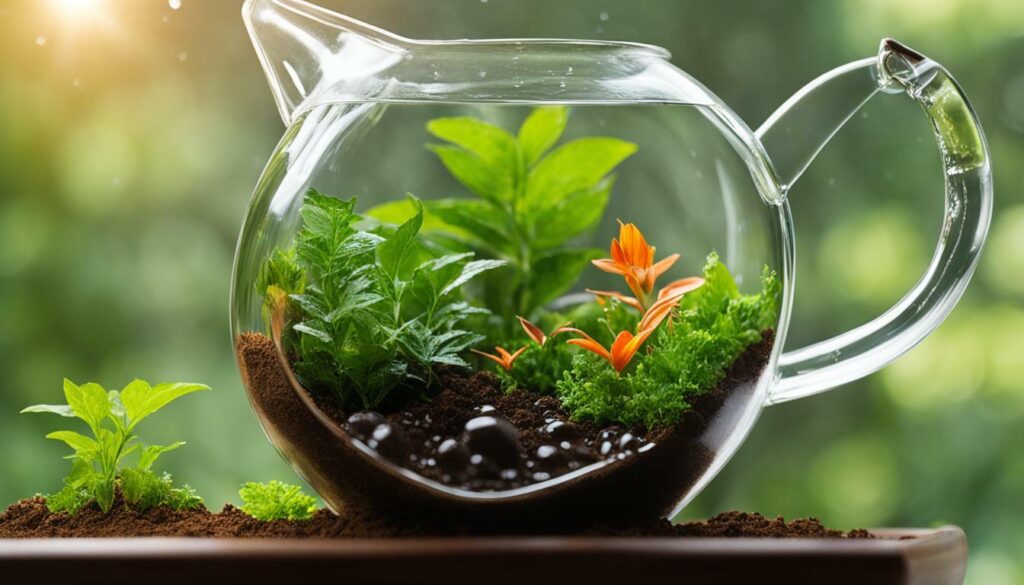
By following these watering guidelines and monitoring your terrarium’s moisture levels, you’ll be able to provide the ideal conditions for your plants to thrive. Remember to prioritize regular maintenance and care to keep your terrarium healthy and visually stunning.
Trimming and Pruning Terrarium Plants
Regularly trimming and pruning your terrarium plants is crucial to ensure their healthy growth and overall aesthetic appeal. By removing dead or yellowing leaves, you not only improve the appearance of your terrarium but also prevent the spread of diseases and maintain a balance in plant density.
When trimming your terrarium plants, it’s important to use sharp and clean scissors or pruning shears. This helps minimize damage to the plants and allows for precise cuts. Start by identifying any unwanted growth or overcrowded areas. Carefully trim away excess foliage, making sure to maintain the desired shape and size of each plant.
For plants that tend to grow tall and leggy, pruning can promote branching and create a more compact and bushy appearance. To encourage branching, simply pinch off the top of the stem or the tips of the leaves. This stimulates the growth of lateral shoots, resulting in a fuller and more attractive plant.
Remember to remove any fallen or decaying plant material from the terrarium regularly. This prevents the accumulation of organic matter that can lead to pests or mold growth. Additionally, cleaning the terrarium glass periodically allows for better visibility and enhances the overall presentation of your terrarium.
| Key Tips for Trimming and Pruning Terrarium Plants: |
|---|
| 1. Use sharp and clean scissors or pruning shears for precise cuts. |
| 2. Remove dead or yellowing leaves to maintain plant health. |
| 3. Keep an eye out for overcrowded areas and trim away excess foliage. |
| 4. Prune tall and leggy plants to promote branching and a compact appearance. |
| 5. Regularly clean the terrarium glass and remove fallen or decaying plant material. |
“Trimming and pruning your terrarium plants not only keeps them healthy but also enhances the visual appeal of your terrarium.” – Terrarium Care Expert
Common Mistakes to Avoid:
- Neglecting to trim and prune regularly, leading to overgrown and messy terrariums.
- Using dull or dirty tools, which can damage the plants and introduce infections.
- Removing too much foliage at once, causing stress to the plants.
- Ignoring fallen or decaying plant material, creating an environment for pests and diseases.
- Skipping regular cleaning of the terrarium glass, reducing visibility and aesthetic appeal.
By following these best practices for trimming and pruning your terrarium plants, you can ensure their healthy development and create a visually stunning indoor display.
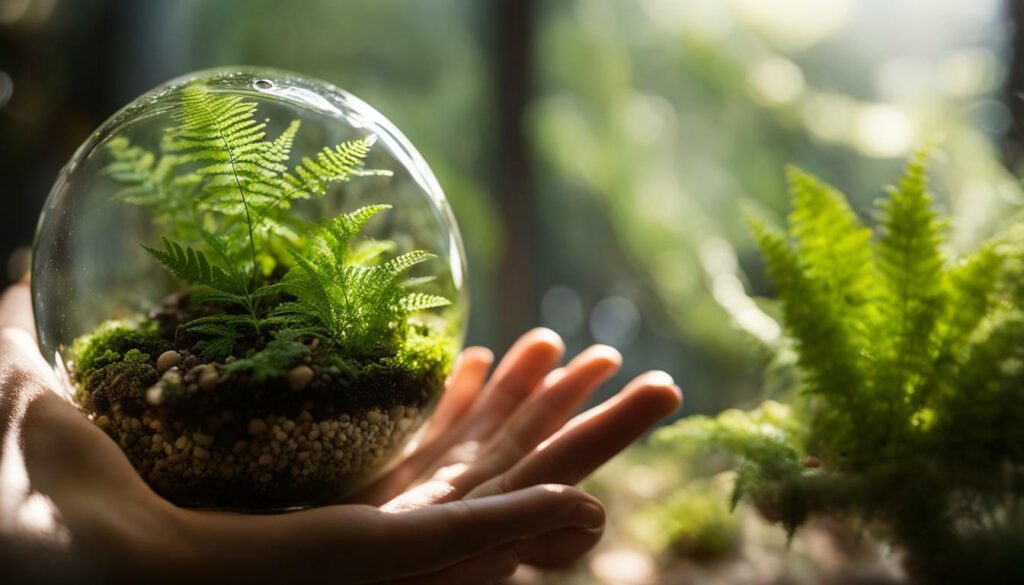
Keeping the glass of your terrarium clean and free from smudges is essential to maintain its visual clarity. Regular cleaning not only improves the aesthetics but also allows for better observation of the plants and their overall health. Here are some DIY tips and cleaning supplies for terrariums to help you achieve a sparkling glass enclosure:
Gentle Cleaning:
When it comes to cleaning the glass of your terrarium, it’s important to use non-abrasive materials and avoid harsh chemicals that can potentially harm the plants. A soft microfiber cloth or a lint-free cloth is ideal for gently wiping away any dust or fingerprints on the glass. For stubborn smudges, dampen the cloth with a mixture of mild soap and water and carefully wipe the affected area. Remember to rinse the cloth thoroughly before wiping the glass again to prevent any residue from the soap.
Preventing Streaks:
To ensure a streak-free shine, it’s recommended to use distilled water or filtered water instead of tap water, as tap water can often contain minerals that may leave streaks on the glass. Additionally, you can add a splash of vinegar to your cleaning solution to help eliminate streaks and maintain the clarity of the glass.
Cleaning the Corners:
When cleaning the corners of your terrarium, where dirt and grime tend to accumulate, use a cotton swab or a soft-bristled brush dipped in your cleaning solution to reach those hard-to-reach areas. Gently scrub the corners to remove any stubborn dirt or algae, ensuring you don’t apply too much pressure that could damage the glass or disturb the plants.
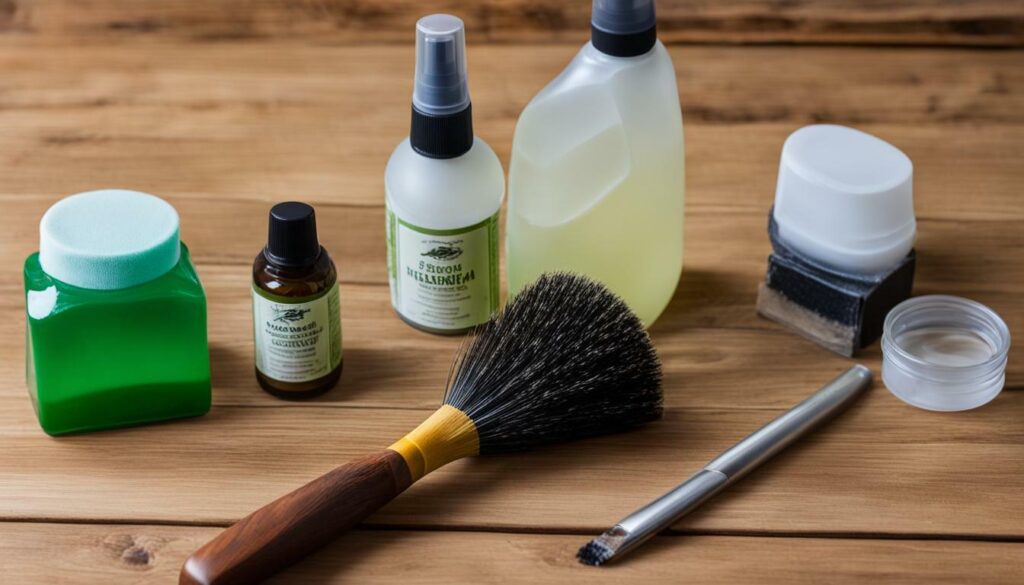
By following these DIY cleaning techniques and using the right supplies, you can maintain the pristine condition of your terrarium glass and enjoy the beauty of your plant collection. Remember to clean the glass regularly to create an optimal environment for your terrarium’s inhabitants and to showcase their natural splendor.
Dealing with Bugs in Your Terrarium
The presence of bugs in your terrarium can be detrimental to the overall well-being of your plants, but there are steps you can take to address this issue. One common bug problem in terrariums is the presence of small insects like aphids or spider mites. These pests can damage the leaves and roots of your plants, leading to their decline. To effectively deal with bugs in your terrarium, follow these expert tips:
- Identify the pests: Carefully examine your plants to identify the type of bugs present. Understanding the specific pests will help you choose the appropriate treatment method.
- Natural remedies: Consider using natural remedies to eliminate bugs from your terrarium. For example, you can introduce beneficial insects like ladybugs, which feed on aphids and other harmful pests.
- Soap solution: Create a soap solution by mixing mild liquid dish soap with water. Spray this solution on the affected plants, focusing on the undersides of the leaves where bugs are often found. Repeat the process every few days until the infestation is resolved.
- Isolate affected plants: If you notice a severe infestation, it’s important to isolate the affected plants from the rest of the terrarium to prevent the pests from spreading. Place the infested plants in quarantine and treat them separately.
- Maintain cleanliness: Regularly clean your terrarium to prevent the buildup of debris, which can attract bugs. Remove fallen leaves, dead plants, and any decaying organic matter that may serve as a breeding ground for pests.
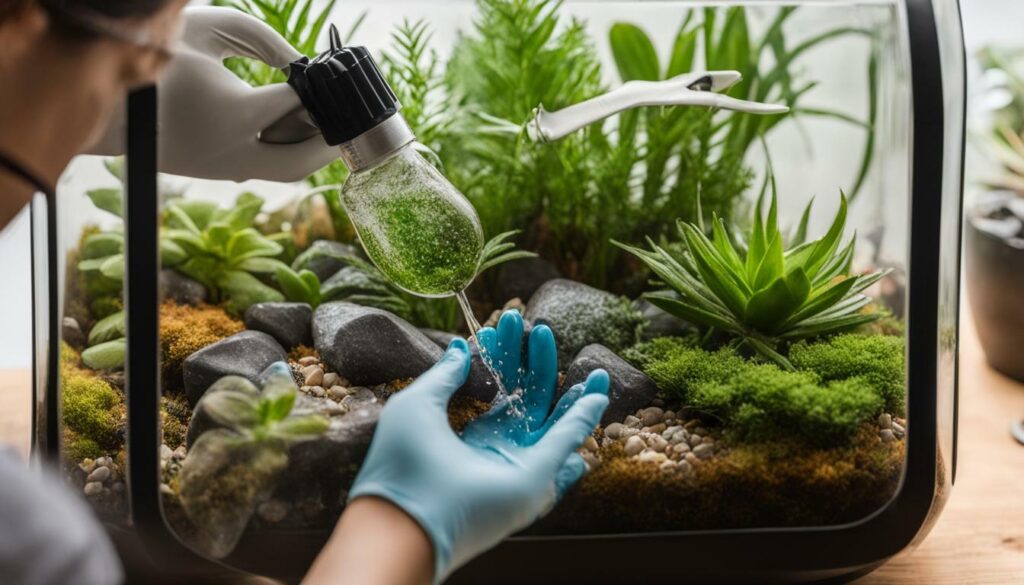
By following these steps, you can effectively control and eliminate bugs in your terrarium, ensuring the health and well-being of your plants. Remember, prevention is key, so regularly inspect your terrarium for signs of pests and take immediate action to protect your plants from potential harm.
Avoiding Common Mistakes in Terrarium Care
By being aware of and avoiding common mistakes, you can significantly improve the health and longevity of your terrarium. Here are some essential tips to keep in mind:
- Choosing the right location: Placing your terrarium in the correct spot is crucial for its success. Consider the light requirements of the plants you have chosen. Some plants thrive in bright, indirect light, while others prefer shade. Avoid placing your terrarium in direct sunlight as it can lead to excessive heat and damage the plants.
- Proper watering: Overwatering or underwatering can harm your terrarium. Closed terrariums require less watering as they create their own humid environment. On the other hand, open terrariums should be watered every 3-6 weeks, depending on the moisture level of the soil.
- Regular trimming and pruning: To maintain the shape and overall health of your terrarium plants, it is vital to regularly trim and prune them. This will prevent overcrowding and allow for proper air circulation, reducing the risk of pests and diseases.
- Gentle cleaning of the glass: Keep the glass of your terrarium clean and clear to maximize visibility and aesthetic appeal. Use a soft cloth to gently wipe away any dust or fingerprints. Avoid using harsh chemicals that can harm the plants or leave residue on the glass.
- Dealing with bugs: If you notice any bugs in your terrarium, it is essential to act promptly. Some common pests include aphids, fungus gnats, and spider mites. Remove any affected plants and use appropriate insecticidal soap to eliminate the pests. Regularly inspect your terrarium to ensure early detection and prevention.
Conclusion
By following these terrarium cleaning tips and best practices, you can create a thriving and visually stunning terrarium. Remember to place it in the right location, water it properly, trim and prune regularly, keep the glass clean, and address any bug infestations promptly. With proper care, your terrarium will continue to bring joy and beauty to your indoor space.
Maintaining a Thriving Terrarium
Consistent cleaning and diligent care are key to maintaining a thriving, beautiful terrarium. By following best practices for cleaning and maintenance, you can ensure that your terrarium remains healthy and visually appealing.
First, it’s important to place your terrarium in the right spot. Consider the light requirements of the plants you have chosen and find a location that provides the appropriate amount of sunlight. Too much direct sunlight can cause damage, while too little can hinder growth. Finding the right balance is crucial for the overall health of your terrarium.
Next, proper watering is essential. Closed terrariums require less watering as they maintain their own humidity. However, open terrariums need to be watered every 3-6 weeks to maintain moisture levels. Overwatering can lead to root rot, so be sure to monitor the soil moisture and adjust accordingly.
In addition to watering, regular trimming and pruning of your terrarium plants is necessary to maintain their shape and prevent overcrowding. This allows for better air circulation and prevents the risk of pests or diseases. Remove any dead or yellowing leaves to encourage new growth and maintain the overall aesthetics of your terrarium.
| Best Practices for Terrarium Care: | Don’t: |
|---|---|
| Place the terrarium in an appropriate location with the right amount of sunlight. | Expose the terrarium to excessive direct sunlight. |
| Water the terrarium according to its specific needs. | Overwater the terrarium, leading to root rot. |
| Trim and prune the terrarium plants regularly. | Allow plants to become overcrowded and neglected. |
| Clean the terrarium glass gently with a soft cloth. | Use harsh chemicals that can damage the glass. |
| Take immediate action if bugs are detected. | Ignore bugs that can spread and harm other plants. |
| Clean the terrarium regularly to maintain its appearance. | Neglect regular cleaning, allowing dirt and grime to accumulate. |
When cleaning the terrarium glass, avoid using harsh chemicals that can damage the delicate plants inside. Gently wipe the glass with a soft cloth to remove any dust or smudges. This will not only improve visibility but also enhance the overall aesthetic appeal of your terrarium.
If you notice any bugs in your terrarium, it’s important to act quickly. Bugs can quickly multiply and spread, causing damage to your plants. Identify the type of bug and take appropriate measures to eliminate them, such as using natural insecticides or manually removing them.
By adhering to these best practices and dedicating regular time for cleaning and maintenance, you can ensure that your terrarium remains healthy and vibrant. With your care and attention, your terrarium will continue to be a beautiful addition to your indoor space.
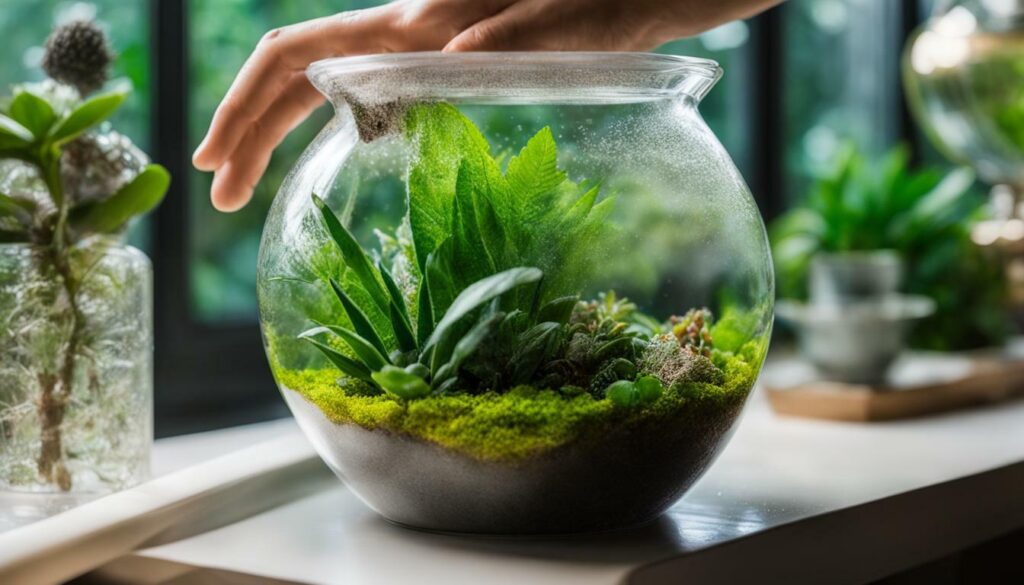
Incorporating effective cleaning and dusting techniques into your terrarium care routine can have a profound impact on its appearance and longevity. By following these terrarium cleaning tips, you can ensure that your miniature ecosystem thrives and continues to be a stunning focal point in your home.
Proper Placement
When deciding where to place your terrarium, consider the light requirements of the plants you have selected. Some plants thrive in bright, indirect light, while others prefer low light conditions. By finding the perfect spot for your terrarium, you can ensure that your plants receive the appropriate amount of light to grow and flourish.
Regular Watering
Watering your terrarium correctly is crucial for maintaining its health. Closed terrariums create their own humidity and require less watering. On the other hand, open terrariums need to be watered every 3-6 weeks, depending on the moisture level of the soil. Overwatering can lead to root rot, so it’s important to strike the right balance to keep your plants happy.
Maintaining Plant Shape
Trimming and pruning your terrarium plants is essential for their overall health and aesthetics. Regularly removing dead or yellowing leaves, as well as trimming back overgrown stems, helps to maintain their shape and prevent overcrowding. This allows each plant to receive the necessary light and airflow for optimal growth.
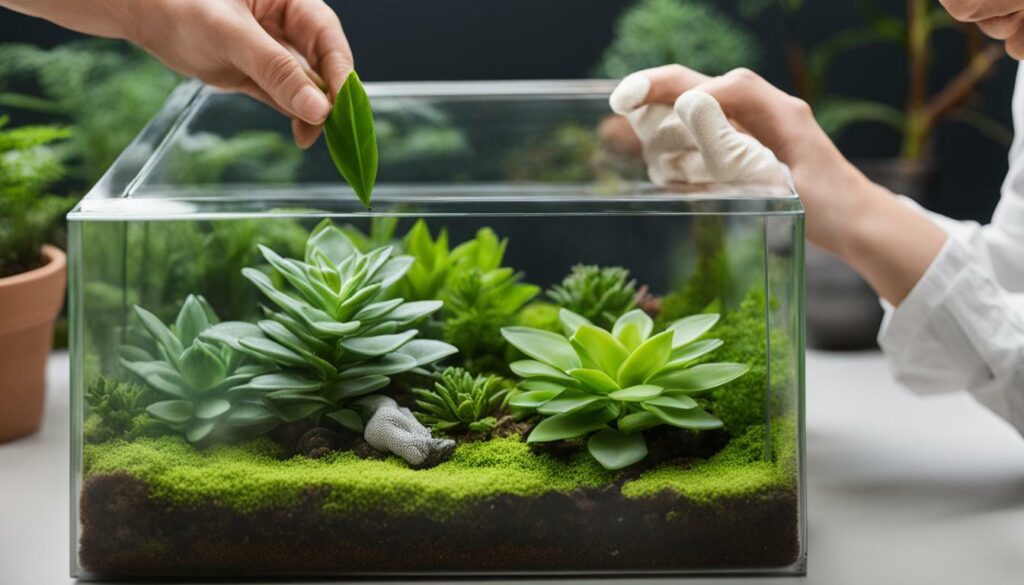
Keeping the glass of your terrarium clean is vital for its visual appeal. Gently wipe away any dust or fingerprints using a soft cloth or sponge. Avoid using harsh chemicals that may be harmful to your plants. A clean glass surface allows for maximum transparency, allowing you to fully enjoy the beauty of your terrarium.
Bug Prevention and Control
Unwanted bugs can pose a threat to your terrarium’s health. Act quickly if you notice any pests, as they can multiply rapidly and harm your plants. Inspect your terrarium regularly and take necessary steps to eliminate any insects that may have found their way inside.
By following these terrarium cleaning tips and incorporating them into your regular care routine, you can ensure that your terrarium remains a thriving, beautiful addition to your indoor space for years to come.
How Does Pruning and Trimming Contribute to Terrarium Cleaning and Maintenance?
Terrarium pruning and trimming are vital for cleaning and maintaining a healthy environment for your plants. Regularly removing dead or overgrown foliage not only keeps the terrarium looking tidy but also allows for better air circulation and light penetration. This helps prevent mold and mildew while promoting plant growth.
Conclusion
Regular cleaning and proper care are essential for maintaining the health and aesthetics of your terrarium. By following these expert tips, you can ensure that your terrarium remains vibrant and visually appealing.
Firstly, it is crucial to place your terrarium in the right spot, considering the light requirements of the plants you have chosen. This will help them thrive and prevent issues related to insufficient or excessive light.
Next, watering your terrarium correctly is vital. Closed terrariums require less watering as they maintain their own humidity, while open terrariums should be watered every 3-6 weeks. Overwatering can lead to root rot, while underwatering can cause your plants to wither.
Trimming and pruning your terrarium plants on a regular basis is also crucial. This helps maintain their shape and prevents overcrowding, ensuring that each plant receives adequate space to grow and thrive.
Furthermore, cleaning the terrarium glass is important for optimal viewing pleasure. Gently wiping the glass with a soft cloth and avoiding harsh chemicals will keep it clear and free from smudges or streaks.
If you notice any bugs in your terrarium, it is important to take immediate action. Bugs can quickly spread and harm other plants. Identifying the pests and using appropriate methods to eliminate them will help keep your terrarium healthy.
Lastly, avoid common mistakes such as placing the terrarium in direct sunlight, neglecting to trim plants, allowing the glass to become too dirty, and infrequent cleaning. These mistakes can hinder the growth and overall health of your terrarium.
By adhering to these cleaning and care practices, your terrarium will thrive and continue to be a beautiful addition to your indoor space. So give your terrarium the attention it deserves and enjoy the benefits it brings to your home or office.
FAQ
Why is cleaning and dusting important for terrarium care?
Cleaning and dusting your terrarium is essential for maintaining its health and aesthetics. Regular cleaning helps remove debris, dust, and potential pests, ensuring that your terrarium remains clean and thriving.
How often should I water my terrarium?
The watering frequency depends on the type of terrarium you have. Closed terrariums require less watering as they maintain their own humidity. Open terrariums should be watered every 3-6 weeks, adjusting based on the moisture levels of the soil.
How should I clean the glass of my terrarium?
Gently wipe the glass with a soft cloth to remove any smudges or dirt. Avoid using harsh chemicals, as they may damage the glass or harm the plants. Consider using a mild soap solution if necessary.
What should I do if I notice bugs in my terrarium?
Act quickly if you notice any bugs in your terrarium, as they can spread and harm other plants. Identify the type of pest and choose an appropriate method for elimination, such as manually removing them or using natural insecticides.
What are some common mistakes to avoid in terrarium care?
Some common mistakes to avoid include placing the terrarium in direct sunlight, neglecting to trim and prune plants, allowing the glass to become too dirty, and infrequent cleaning. These mistakes can negatively impact the health and appearance of your terrarium.

